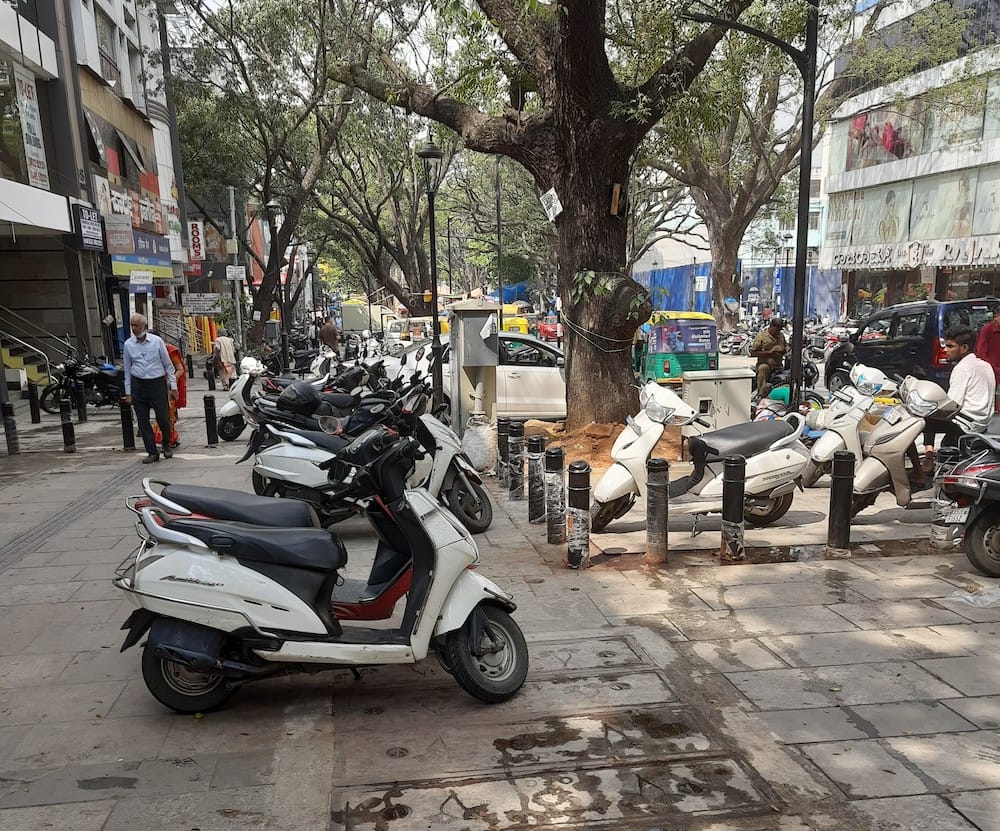Part 1 looked at the details of the Bengaluru Climate Action and Resilience Plan (BCAP), its objectives, focus areas, resource planning, etc. The Government of Karnataka has tasked Bruhat Bengaluru Mahanagara Palike (BBMP) with the primary leadership and responsibility for this initiative.
While plans on paper seem comprehensive, the ground reality, however, leaves much to be desired. The challenges are many. The government needs to put in place a governance structure to execute them, considering that BBMP, entrusted with the primary leadership responsibility, hasn’t had an election for over seven years!
What does sustainable and healthy living-an objective of BCAP-mean for citizens?
- Increase green cover and open spaces up to 10%: There should be more trees and green spaces in our neighbourhoods. There are shockingly low numbers of trees in Bengaluru as per this IISc report: Trees of Bengaluru. The report is from 2014, so we assume that the situation is even worse at present. The BBMP has refused to complete a High Court mandated Tree Survey for Bengaluru.
- News report ‘trees gone, city now a concrete jungle’: According to a report by The Indian Institute of Science (IISc), “there are merely 1.5 million trees to support the city’s population of 9.5 million, which in effect means there is only one tree for every seven persons in Bengaluru. “This is insufficient even to sequester respiratory carbon”
- Role of trees to counter Climate Change: Trees and every facet of greenery as well as water bodies are the most important resources for capture and storage of carbon from the atmosphere. So, where does this leave the BCAP in pursuing its goals?
- Preservation of lakes: Reports suggest that we have lost 79% of water bodies and 88% of green cover. This is indeed alarming and we need to act fast and effectively.
Public transport: Bengaluru must aim to achieve 70% to 80% trips through public transport and non-motorised transport (NMT) systems. Reduce the number of private vehicles on the road, air pollution, traffic congestion etc. - Make Bengaluru 100% walkable and cycleable (non-motorised transport): This should include the needs of the differently-abled community, excluding a few of the CBD areas, most of Bengaluru is today unwalkable and un-cycleable. Children cannot either walk or cycle to their neighbourhood schools. Currently, we have an alarming rate of pedestrian accidents and deaths. If you look at the Department of Urban Land Transport (DULT) webpage, you will notice that while it mentions and lists multiple initiatives, there is no top down vision statement that citizens can comprehend and get a sense of where Bengaluru would be in the next five years.
Solid Waste Management: Stop landfilling in the near future, since it adversely impacts the lives of those living in the neighbourhood of landfills.
How BCAP can achieve citizen’s aspirations:
- Bold announcements should be made by the Karnataka government, and in particular by the Minister for Bengaluru. We expect them to articulate their vision and set targets and timelines.
- Institutional and process-driven decision making: The state government must restore primacy of the various parastatal agencies referred above and not short-cut the process arbitrarily. This is the only way to ensure accountability and get the confidence of citizens.
- Communications with citizens: This must be achieved in a transparent and continuous manner, all related planning documents should be made available to the public. Obtaining the support of citizens is the key to success.
What can we learn from some of the other C40 cities?
| Cities | Climate Action plans |
| London | 1. The Mayor has set an ambitious target of increasing the amount of green cover in central London by 5% by 2030 and by 10% by 2050 (based on a 2008 baseline). 2. The overarching goal of the Mayor’s Transport Strategy is that by 2041, 80% of journeys are to be made by walking, cycling and public transport. 3. London has a Walking and Cycling Commissioner since 2016. |
| Stockholm | The Walkable City plan will drive Stockholm’s goal of becoming carbon neutral by 2030. Stockholm’s long-term goal is to become a “fossil fuel free city” by 2040. |
| New York | No landfills by 2030: To tackle this situation, New York City has set a goal of reducing the amount of waste by 90% by 2030 from a 2005 baseline. It will also send zero waste to landfill by that point. |
| Paris | Plan Velo: Act 2, is slated to make Paris 100% cycleable by 2026. |
Shouldn’t the Minister of Bengaluru take a cue and express his vision in simple terms (as above), so that every citizen gets a clear signal of the state government’s intent and sense of direction?

Read more: Deluge or drought: Water researchers explain how Bengaluru can build resilience
Adequate funding for projects
- Prioritising long term initiatives: The GoK is currently struggling with finances. We assume all desirable projects will likely not get adequate funding. So, projects must be prioritised based on some criteria. Involving citizens in this exercise will serve the purpose of confidence building.
- An example of insufficient allocation for lakes: Palike allocates Rs 35 crore to maintain 174 lakes . Even if this is towards maintenance of these 174 lakes, this amount appears wholly inadequate. Preservation and rejuvenation of lakes, by all accounts, has been handled in a casual and callous manner over the last two decades.
This report in Citizen Matters mentions allocation of Rs 25 lakhs for footpath maintenance for each ward. What about wards where there are no footpaths?
Outcomes: Chasing projects and not specifying and closely monitoring outcomes serves no purpose. Councillors and ward committees must be involved. Sadly, as on date, both do not exist.
In conclusion
- BCAP is a long overdue initiative, considering that issues relating to climate change have been gaining momentum over the last 20 to 30 years.
- Brand Bengaluru must leverage its status as a Global Innovation City and its vast intellectual capital and become a leading global city in all aspects of meeting the challenges of climate change.
- The Minister of Bengaluru needs to lead from the front and announce an ambitious vision and set targets.
- Government initiatives and urban governance: The parastatal agencies need to be activated and the BBMP elections must be conducted soon.
A word of caution: we simply need to set our house in order for the BCAP to succeed.

Unless there is a will to change and reduce emissions, we can’t succeed. We need strong willed civil society to fight and join the Govt. to achieve our objectives and become greener & cleaner by 2050 at least.
I find a small factual error. The writer presumes the population as 9.5 million. This could be long back documented figure. Now, we are looking at 14 to 15 million. The concern would be more alarming than noted here in the article. Kudos to the writer for such a researched presentation.
In Singapore they have nature reserves..which consists of small water bodies ( lakes) .They are reserved and taken care by authorities strictly.
Dedicates small parks with senior citizens walkways,and exercise areas .
We should also earmark in Bengaluru and go on these ideas.
Raghavendra Cavale
Kengeri
This is both an individual and a collective responsibility… unless we start being conscious of how we live in our homes, we will not be conscious about our environment… my mantra for the last few years has been – recycle, reuse, reduce and refuse …